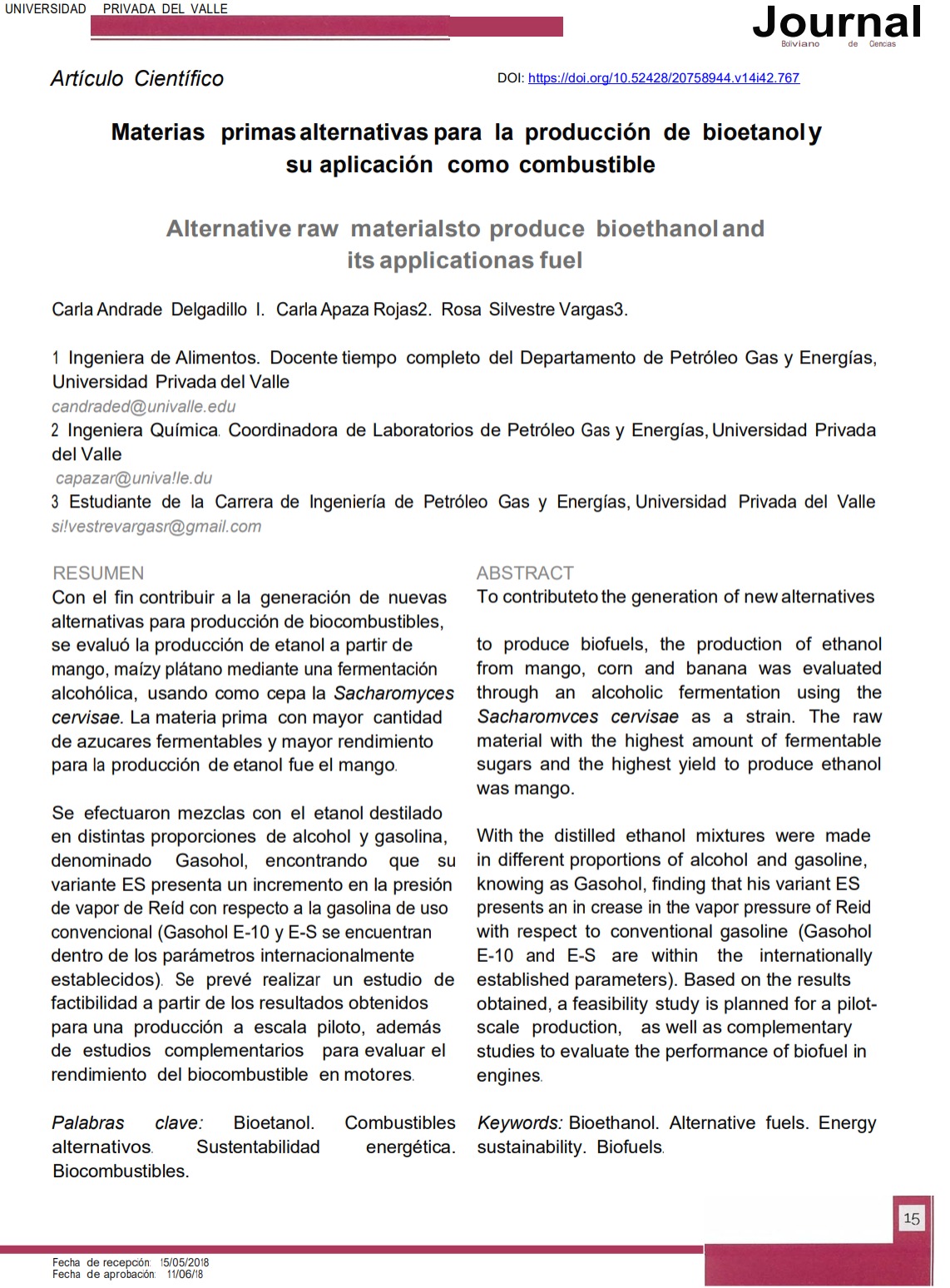Alternative Raw Materials to Produce Bioethanol and its Application as Fuel
DOI:
https://doi.org/10.52428/20758944.v14i42.767Keywords:
Bioethanol, Alternative Fuels, Energy Sustainability, BiofuelsAbstract
To contributeto the generation of new alternatives to produce biofuels, the production of ethanol from mango, corn and banana was evaluated through an alcoholic fermentation using the Sacharomyces cervisae as a strain. The raw material with the highest amount of fermentable sugars and the highest yield to produce ethanol was mango. With the distilled ethanol mixtures were made in different proportions of alcohol and gasoline, knowing as Gasohol, finding that his variant ES presents an in crease in the vapor pressure of Reid with respect to conventional gasoline (Gasohol E-10 and E-S are within the internationally established parameters). Based on the results obtained, a feasibility study is planned for a pilotscale production, as well as complementary studies to evaluate the performance of biofuel in engines.
Downloads
References
(1) Aburto, J. y Martínez, T. (2008). Evaluación Técnico-económica de la producción de bioetanol a partir de resisuos lignocelulósicos. México: Instituto Mexicano de Ingenieros Químicos A.C.p. 23-30.
(2) Grácida, J. (2014) Factores previos involucrados en la producción de bioetanol, aspectos a considerar. Revista Internacional de contaminación ambiental. México: Universidad Nacional Autónoma de México. 30(2): 213-227
(3) Quintero, L. et al (2015). Evaluacion de residuos de papa, yuca y naranja para la producción de etanol en cultivo discontinuo utilizando Sacharomyces cervisiae. Revista ION. Colombia: Universidad Industrial de Santander. 43-54.
(4) Fernández, L., Montiel J., M i ll á n A. y Badillo J.A. (2012). Producción de biocombustibles a partir de microalgas. Ra X i m h a i . El Fuerte, México: Universidad Autónoma Indígena de México. 8(3b): 101-115. https://doi.org/10.35197/rx.08.03.e2.2012.10.lf
(5) Velásquez, H., Ruiz, A. y de Oliveira S. {2010). Análisis energético y exergético del proceso de obtención de etanol a partir de la fruta del banano. Revista Facultad de Ingeniería Universidad de Antioquia. Colombia: Universidad de Antioquía. (51), 87-96. Recuperado el 25 de agosto de 2017 de http://www.scielo.org.co/scielo.php?script=sci_arttext&pid=S0120-62302010000100010&1ng=en&tlng=es
(6) Núñez, J. y García P. (2012). Biocombustibles: Bioetanol y Biodiesel. Universidad de Santiago de Compostela, España: Miliarium. Recuperado el 25 de agosto de 2017 de http://www.enciga.org/files/boletins/61/biocombustibles_bioetanol_y_biodiesel.pdf
(7) Montaña, H. {2014). Estudio de factibilidad para u n a planta de bioetanol a partir del aprovechamiento de cascaras de plátano en la empresa Colombian Biofuel S.A.S. Trabajo de grado para optar el título de Administrador Industrial. Universidad de Cartagena, Cartagena, Colombia. Recuperado el 25 de agosto del 2017 de http://190.242.62.234:8080/jspui/bitstream/11227/1293/l/378-%20TTG%20-%20ESTUDIO%20DE%20FACTIBILIDAD%20PARA%20UNA%20PLANTA%20DE%20BIOETANOL%20A%20PARTIR%20DEL%20APROVECHAMIENDO%20DE%20CASCARAS%20DE%20PLATANO%20EN%20LA%20EMPRESA%20COLOMBIAN%20BIOFUEL%20S.A.S.pdf
(8) The United States Pharmacopeial Convention, l. (2014). USP 37. Farmacopea de los Estados Unidos de América. N F 32. Formulario nacional. E E . U U . : United Book Press. P. 1988-1990.

Downloads
Published
How to Cite
Issue
Section
License
Copyright (c) 2018 Carla Andrade Delgadillo, Carla Apaza Rojas y Rosa Silvestre Vargas

This work is licensed under a Creative Commons Attribution 4.0 International License.
Authors who publish with this journal agree to the following terms:
- Authors retain copyright and grant the journal right of first publication with the work simultaneously licensed under a Creative Commons Attribution License 4.0 that allows others to share the work with an acknowledgement of the work's authorship and initial publication in this journal.
- Authors are able to enter into separate, additional contractual arrangements for the non-exclusive distribution of the journal's published version of the work (e.g., post it to an institutional repository or publish it in a book), with an acknowledgement of its initial publication in this journal.
- Authors are permitted and encouraged to post their work online (e.g., in institutional repositories or on their website) prior to and during the submission process, as it can lead to productive exchanges, as well as earlier and greater citation of published work.














